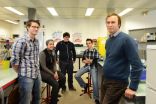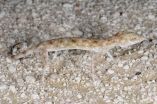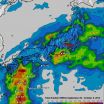Hospitalized patients don't wash their hands enough, study finds
2014-10-07
(Press-News.org) Hamilton, ON (October 7, 2014) – Hospital visitors and staff are greeted with hand sanitizer dispensers in the lobby, by the elevators and outside rooms as reminders to wash their hands to stop infections, but just how clean are patients' hands?
A study led by McMaster University researcher Dr. Jocelyn Srigley has found that hospitalized patients wash their hands infrequently. They wash about 30 per cent of the time while in the washroom, 40 per cent during meal times, and only three per cent of the time when using the kitchens on their units. Hand hygiene rates were also low on entering and leaving their hospital room, at about three per cent and seven per cent respectively.
"This is important because getting patients to wash their hands more could potentially reduce their risk of picking up infections in the hospital," said principal investigator Srigley, an assistant professor of medicine at McMaster's Michael G. DeGroote School of Medicine and the associate medical director for infection prevention and control at Hamilton Health Sciences.
The research was published online in Infection Control and Hospital Epidemiology.
Much is known about the importance of health care worker hand hygiene in preventing infections in hospital, but there has been little emphasis on the hand hygiene behaviour of patients as a way to reduce the spread of infection.
Srigley and her team looked at the hand hygiene of 279 adult patients in three multi-organ transplant units of a Canadian acute care teaching hospital over an eight-month period. The researchers used new electronic hand hygiene monitoring technology involving sensors on all soap and sanitizer dispensers, to assess this behaviour. The same system was used by the team in its recent study that discovered fewer health care workers wash their hands when not being watched.
Organisms such as Clostridium difficile (C. difficile) or norovirus can survive on skin and surfaces, contaminate patients' hands, and then be ingested, leading to infection. Similarly, MRSA (methicillin-resistant Staphylococcus aureus) and respiratory viruses could also be acquired by patients from the environment by way of their hands, the authors noted.
Srigley said that with the current lack of focus on patient hand hygiene, this study's results are not surprising. Furthermore, it is already known that health care worker hand hygiene is far from ideal despite intensive efforts to improve it through education, promotional materials and feedback.
"At the hospital where this study was conducted, patients were not given any specific information about hand hygiene," said Srigley.
"We can't expect patients to know when to wash their hands if we don't inform them, so it's not surprising that they wash their hands infrequently. In particular for washing hands when entering and exiting their room, it's not something that I would expect patients to think of doing unless they were educated and reminded to do that."
INFORMATION:
The study received funding from Canada Health Infoway and the Health Technology Exchange.
For more information:
Veronica McGuire
Media Relations
Faculty of Health Sciences
McMaster University
vmcguir@mcmaster.ca
905-525-9140, ext. 22169
ELSE PRESS RELEASES FROM THIS DATE:
2014-10-07
LONDON, ON – New research shows probiotic yogurt can reduce the uptake of certain heavy metals and environmental toxins by up to 78% in pregnant women. Led by Scientists at Lawson Health Research Institute's Canadian Centre for Human Microbiome and Probiotic Research, this study provides the first clinical evidence that a probiotic yogurt can be used to reduce the deadly health risks associated with mercury and arsenic.
Environmental toxins like mercury and arsenic are commonly found in drinking water and food products, especially fish. These contaminants are particularly ...
2014-10-07
Two years ago, Prof. Eshel Ben-Jacob of Tel Aviv University's School of Physics and Astronomy and Rice University's Center for Theoretical Biological Physics made the startling discovery that cancer, like an enemy hacker in cyberspace, targets the body's communication network to inflict widespread damage on the entire system. Cancer, he found, possessed special traits for cooperative behavior and used intricate communication to distribute tasks, share resources, and make decisions.
In research published in the Early Edition of the Proceedings of the National Academy of ...
2014-10-07
NOAA's GOES-West satellite took a picture of Tropical Storm Simon weakening over Mexico's Baja California.
On Oct. 7, a Tropical Storm Watch was in effect for Punta Abreojos to Punta Eugenia, Mexico. The National Hurricane Center expects Simon to produce storm total rainfall amounts of 3 to 5 inches with isolated amounts around 8 inches through Wednesday, Oct. 8, across northern portions of the Baja California Peninsula and the state of Sonora in northwestern Mexico. Over the next few days, storm total rainfall amounts of 1 to 2 inches with isolated amounts of around ...
2014-10-07
Eating disorders (ED) such as anorexia nervosa, bulimia, and binge eating disorder affect approximately 5-10% of the general population, but the biological mechanisms involved are unknown. Researchers at Inserm Unit 1073, "Nutrition, inflammation and dysfunction of the gut-brain axis" (Inserm/University of Rouen) have demonstrated the involvement of a protein produced by some intestinal bacteria that may be the source of these disorders. Antibodies produced by the body against this protein also react with the main satiety hormone, which is similar in structure. According ...
2014-10-07
A new study led by Professor Kui Liu at the University of Gothenburg has identified the key molecule 'Greatwall kinase' which protects women's eggs against problems that can arise during the maturation process.
In order to be able to have a child, a woman needs eggs that can grow and mature. One of these eggs is then fertilised by a sperm, forming an embryo. During the maturation process, the egg needs to go through a number of stages of reductional division, called meiosis. If problems occur during any of these stages, the woman can become infertile. Around 10-15% of ...
2014-10-07
The Gulf Sand gecko is a remarkable desert reptile in that it is the only lizard found habitually on sabkha substrate across large parts of the eastern Arabian Peninsula. These arid salt flats constitute one of the harshest habitats on earth, due to their extraordinary salinity.
The Gulf gecko, Pseudoceramodactylus khobarensis, belongs to a genus with a single species, and it is well adapted to this substrate featuring spiny scales beneath the fingers, long extremities and swollen nostrils.
Data on its distribution range showed a conspicuous gap between eastern United ...
2014-10-07
October 7, 2014 – For women undergoing breast reconstruction using the advanced "DIEP" technique, a simple formula can reliably tell whether there will be sufficient blood flow to nourish the DIEP flap, reports a paper in Plastic and Reconstructive Surgery—Global Open®, the official open-access medical journal of the American Society of Plastic Surgeons (ASPS).
Drs Joseph Richard Dusseldorp and David G. Pennington of Macquarie University Hospital, Sydney, performed an ultrasound study to see how well the flap viability index (FVI) equation predicted blood ...
2014-10-07
DETROIT – The only drug currently approved for treatment of stroke's crippling effects shows promise, when administered as a nasal spray, to help heal similar damage in less severe forms of traumatic brain injury.
In the first examination of its kind, researchers Ye Xiong, Ph.D, Zhongwu Liu, Ph.D., and Michael Chopp, Ph.D., Scientific Director of the Henry Ford Neuroscience Institute, found in animal studies that the brain's limited ability to repair itself after trauma can be enhanced when treated with the drug tPA, or tissue plasminogen activator.
"Using this ...
2014-10-07
Undergoing an experience with another person — even if we do it in silence, with someone we met just moments ago — seems to intensify that experience, according to new research published in Psychological Science. The research shows that people who share experiences with another person rate those experiences as more pleasant or unpleasant than those who undergo the experience on their own.
"We often think that what matters in social life is being together with others, but we've found it also really matters what those people are doing," says psychological scientist ...
2014-10-07
Typhoon Phanfone packed heavy rainfall as it brushed over Japan and NASA's TRMM satellite identified where the rain fell. That data was used to make a map of rainfall totals.
The Tropical Rainfall Measuring Mission or TRMM satellite has the ability to calculate rainfall rates within storms as it orbits around the Earth's tropics from space. TRMM data can also be used to create rainfall maps that show how much rain has fallen over given areas.
Phanfone was a powerful super typhoon with sustained wind speed estimated at 130 knots (150 mph) as it approached Japan but ...
LAST 30 PRESS RELEASES:
[Press-News.org] Hospitalized patients don't wash their hands enough, study finds




